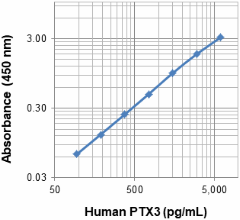- Regulatory Status
- RUO
- Other Names
- PTX-3, Pentraxin 3, TSG-14, TNFAIP5, Tumor Necrosis Factor Inducible Gene 14 Protein, Tumor Necrosis Factor Alpha-Induce Protein 5, TNF Alpha-Induced Protein 5
- Ave. Rating
- Submit a Review
- Product Citations
- publications

| Cat # | Size | Price | Quantity Check Availability | Save | ||
|---|---|---|---|---|---|---|
| 446807 | 1 Pre-coated Plate | 462 CHF | ||||
PTX3 is part of the pentraxin family which is characterized by a cyclic multimeric structure. Penatraxins are acute phase proteins that act as pattern recognition receptors. PTX3 is a long pentraxin containing a C terminal domain similar to other members of the pentraxin family and a unique N terminal domain. Inflammatory signals stimulate PTX3 production by a variety of cells including mononuclear phagocytes, dendritic cells, fibroblasts, and endothelial cells.
Serum levels of PTX3 increase rapidly in response to a variety of inflammatory and infectious conditions including endotoxic shock and sepsis. PTX3 has been proposed as an early diagnostic marker for septic shock. PTX3 can activate the classical complement pathway, aiding in pathogen recognition by macrophages and dendritic cells. PTX3 is also believed to play an important role in protection against autoimmunity by enhancing complement-mediated clearing of apoptotic cells and restricting cross presentation. Current research has also indicated that PTX3 is involved in initiating the process of tissue repair and plays a role in female fertility. PTX3 is believed to be involved in cancer-related inflammation and high PTX3 levels have been correlated with clinical stage and severity for various cancers.
BioLegend’s LEGEND MAX™ Human PTX3 ELISA kit is a Sandwich Enzyme-Linked Immunosorbent Assay (ELISA) with a 96-well strip plate. The plate is pre-coated with a monoclonal mouse capture antibody. The detection antibody is a biotinylated monoclonal mouse antibody. This kit is specifically designed for the accurate quantitation of human PTX3 from cell culture supernatant, serum, plasma and other biological fluids. It is analytically validated with ready-to-use reagents.
Kit Contents
- Kit Contents
-
- Human PTX3 Pre-coated 96-well Strip Microplate
- Human PTX3 Dectection Antibody
- Human PTX3 Standard
- Avidin-HRP
- Assay Buffer G
- Assay Buffer B
- Wash Buffer (20X)
- Substrate Solution F
- Stop Solution
- Plate Sealers
Product Details
- Verified Reactivity
- Human
- Application
-
ELISA
- Sensitivity
- 10.6 + 1.68 pg/mL
- Standard Range
- 6 - 0.09375 ng/mL
- Materials Not Included
-
- Microplate reader able to measure absorbance at 450 nm
- Adjustable pipettes to measure volumes ranging from 1 µL to 1,000 µL
- Deionized water
- Wash bottle or automated microplate washer
- Log-Log graph paper or software for data analysis
- Polypropylene tubes to prepare standard dilutions
- Timer
- Plate Shaker
- Polypropylene vials
Antigen Details
- Cell Type
- Dendritic cells, Endothelial cells, Fibroblasts, Monocytes
- Biology Area
- Complement, Immunology, Innate Immunity
- Molecular Family
- Innate Immune Signaling
- Gene ID
- NA
- UniProt
- View information about PTX3 on UniProt.org
Related FAQs
- In your LEGEND MAX™ ELISA Kits, there is a step that calls for washing the plates before adding sample. What is the purpose of this step?
-
We typically use a stabilizer for pre-coated plates. The additional washing step is designed to remove these components before you start the assay. If you do not perform the washing, the effect on assay performance is negligible.
- I have multiple LEGEND MAX™ ELISA kits that I want to run simultaneously. Can I use the same wash buffer for all the kits?
-
The wash buffer provided in all our LEGEND MAX™ kits is the same and the part numbers on the wash buffer bottles in these kits should be identical. For ELISA MAX™ Deluxe and ELISA MAX™ Standard Sets, we provide a recipe for the wash buffer on each kit’s technical data sheet. This recipe is the same for all ELISA MAX™ sets.
- For some of your ELISA kits, why do my serum samples require dilution with assay buffer?
-
In some cases, dilution with assay buffer is required to minimize the matrix difference between the samples and the standards to achieve better accuracy.
 Login / Register
Login / Register 









Follow Us